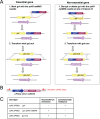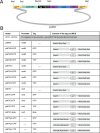Extending the Schizosaccharomyces pombe molecular genetic toolbox
- PMID: 24848109
- PMCID: PMC4029729
- DOI: 10.1371/journal.pone.0097683
Extending the Schizosaccharomyces pombe molecular genetic toolbox
Abstract
Targeted alteration of the genome lies at the heart of the exploitation of S. pombe as a model system. The rate of analysis is often determined by the efficiency with which a target locus can be manipulated. For most loci this is not a problem, however for some loci, such as fin1+, rates of gene targeting below 5% can limit the scope and scale of manipulations that are feasible within a reasonable time frame. We now describe a simple modification of transformation procedure for directing integration of genomic sequences that leads to a 5-fold increase in the transformation efficiency when antibiotic based dominant selection markers are used. We also show that removal of the pku70+ and pku80+ genes, which encode DNA end binding proteins required for the non-homologous end joining DNA repair pathway, increases the efficiency of gene targeting at fin1+ to around 75-80% (a 16-fold increase). We describe how a natMX6/rpl42+ cassette can be used for positive and negative selection for integration at a targeted locus. To facilitate the evaluation of the impact of a series of mutations on the function of a gene of interest we have generated three vector series that rely upon different selectable markers to direct the expression of tagged/untagged molecules from distinct genomic integration sites. pINTL and pINTK vectors use ura4+ selection to direct disruptive integration of leu1+ and lys1+ respectively, while pINTH vectors exploit nourseothricin resistance to detect the targeted disruption of a hygromycin B resistance conferring hphMX6 cassette that has been integrated on chromosome III. Finally, we have generated a series of multi-copy expression vectors that use resistance to nourseothricin or kanamycin/G418 to select for propagation in prototrophic hosts. Collectively these protocol modifications and vectors extend the versatility of this key model system.
Conflict of interest statement
Figures









References
-
- Gutz H, Heslot H, Leupold U, Loprieno N (1974) Schizosaccharomyces pombe. In: King RC, editor. Handbook of Genetics. New York: Plenum press. 395–445.
-
- Moreno S, Klar A, Nurse P (1991) Molecular genetic analysis of fission yeast Schizosaccharomyces pombe . Methods In Enzymology 194: 795–823. - PubMed
-
- Reaume SE, Tatum EL (1949) Spontaneous and nitrogen mustard-induced nutritional deficiencies in Saccharomyces cerevisiae . Arch Biochem 22: 331–338. - PubMed
-
- Leupold U (1970) Genetical methods for Schizosaccharomyces pombe. In: Prescott D, editor. Methods in cell physiology. New York: Academic Press. 169–177.
Publication types
MeSH terms
Substances
Grants and funding
LinkOut - more resources
Full Text Sources
Other Literature Sources
Research Materials

